2017 NISSAN LEAF radio antenna
[x] Cancel search: radio antennaPage 11 of 424
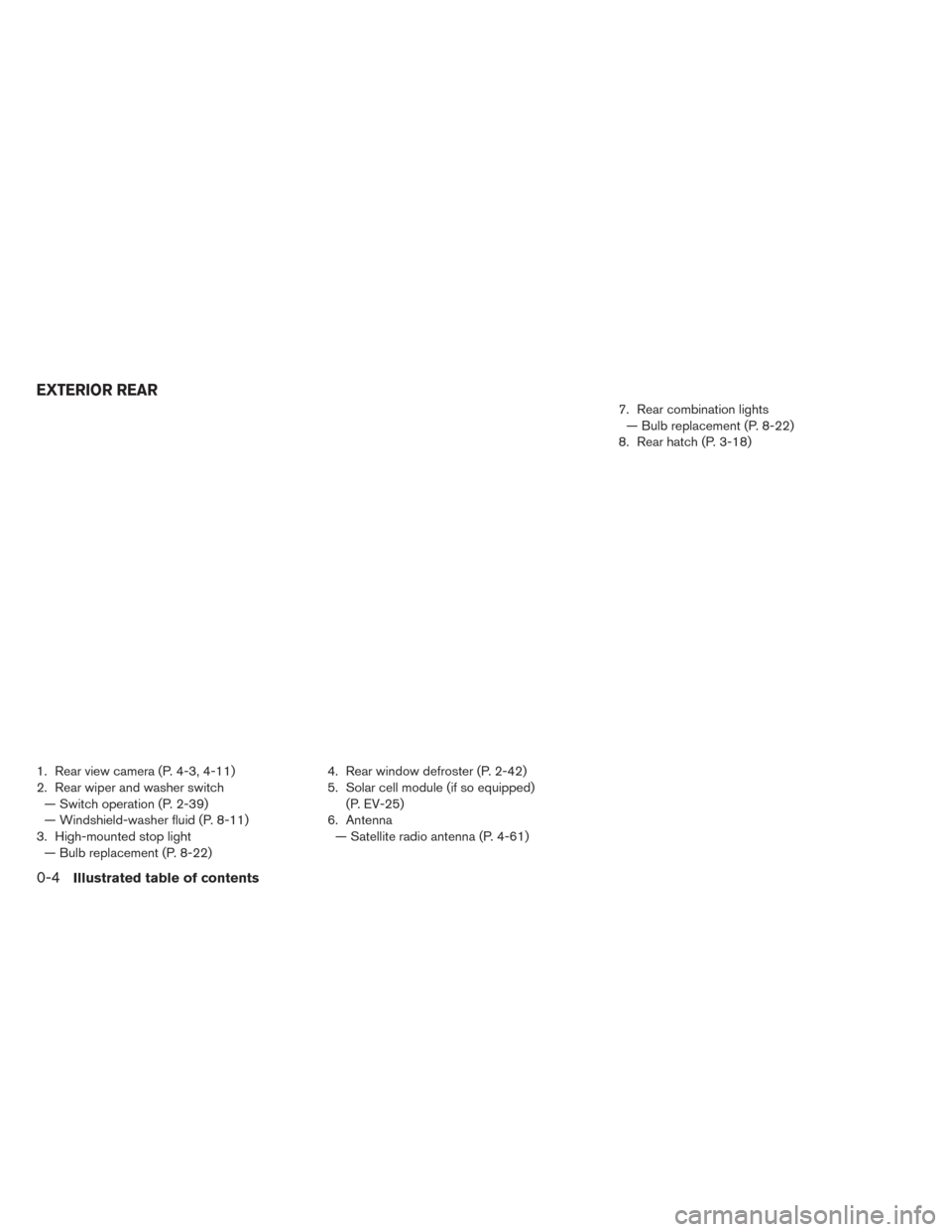
1. Rear view camera (P. 4-3, 4-11)
2. Rear wiper and washer switch— Switch operation (P. 2-39)
— Windshield-washer fluid (P. 8-11)
3. High-mounted stop light — Bulb replacement (P. 8-22) 4. Rear window defroster (P. 2-42)
5. Solar cell module (if so equipped)
(P. EV-25)
6. Antenna — Satellite radio antenna (P. 4-61) 7. Rear combination lights
— Bulb replacement (P. 8-22)
8. Rear hatch (P. 3-18)
EXTERIOR REAR
0-4Illustrated table of contents
Page 231 of 424
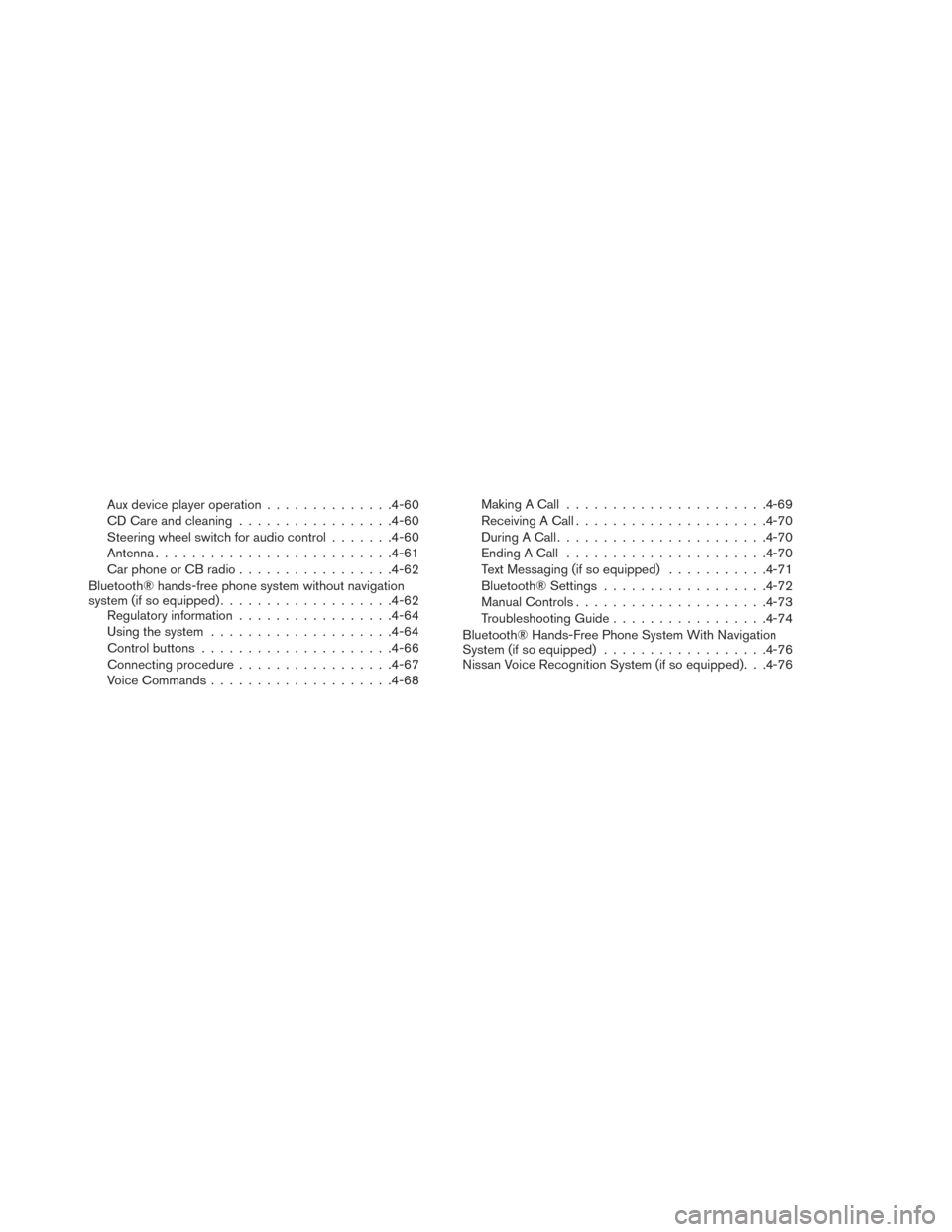
Aux device player operation..............4-60
CD Care and cleaning ................ .4-60
Steering wheel switch for audio control .......4-60
Antenna ......................... .4-61
Car phone or CB radio ................ .4-62
Bluetooth® hands-free phone system without navigation
system (if so equipped) .................. .4-62
Regulatory information ................ .4-64
Using the system ................... .4-64
Control buttons .................... .4-66
Connecting procedure ................ .4-67
Voice Commands ................... .4-68Making A Call
..................... .4-69
Receiving A Call .................... .4-70
During A Call ...................... .4-70
Ending A Call ..................... .4-70
Text Messaging (if so equipped) ...........4-71
Bluetooth® Settings ................. .4-72
Manual Controls .................... .4-73
Troubleshooting Guide ................ .4-74
Bluetooth® Hands-Free Phone System With Navigation
System (if so equipped) ................. .4-76
Nissan Voice Recognition System (if so equipped). . .4-76
Page 272 of 424
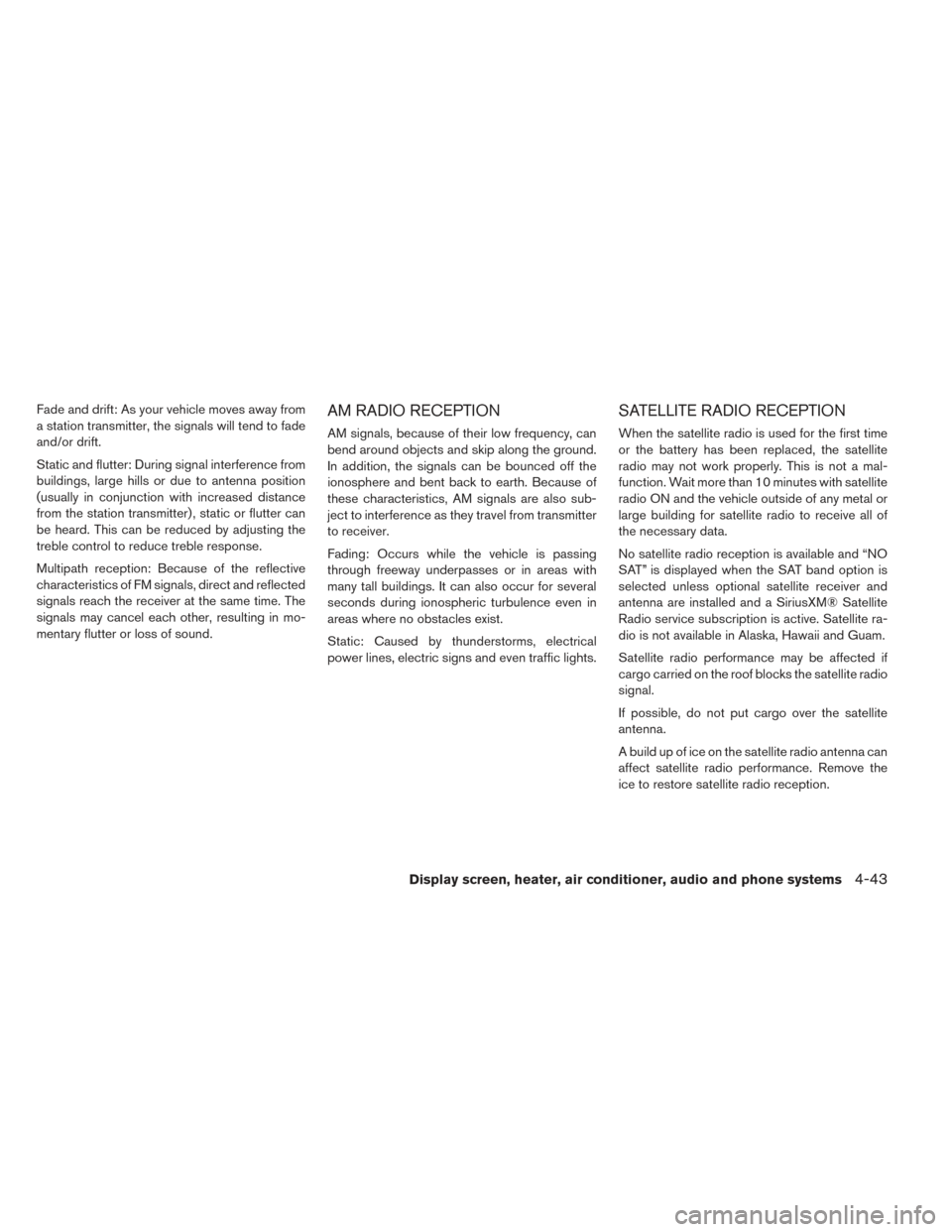
Fade and drift: As your vehicle moves away from
a station transmitter, the signals will tend to fade
and/or drift.
Static and flutter: During signal interference from
buildings, large hills or due to antenna position
(usually in conjunction with increased distance
from the station transmitter) , static or flutter can
be heard. This can be reduced by adjusting the
treble control to reduce treble response.
Multipath reception: Because of the reflective
characteristics of FM signals, direct and reflected
signals reach the receiver at the same time. The
signals may cancel each other, resulting in mo-
mentary flutter or loss of sound.AM RADIO RECEPTION
AM signals, because of their low frequency, can
bend around objects and skip along the ground.
In addition, the signals can be bounced off the
ionosphere and bent back to earth. Because of
these characteristics, AM signals are also sub-
ject to interference as they travel from transmitter
to receiver.
Fading: Occurs while the vehicle is passing
through freeway underpasses or in areas with
many tall buildings. It can also occur for several
seconds during ionospheric turbulence even in
areas where no obstacles exist.
Static: Caused by thunderstorms, electrical
power lines, electric signs and even traffic lights.
SATELLITE RADIO RECEPTION
When the satellite radio is used for the first time
or the battery has been replaced, the satellite
radio may not work properly. This is not a mal-
function. Wait more than 10 minutes with satellite
radio ON and the vehicle outside of any metal or
large building for satellite radio to receive all of
the necessary data.
No satellite radio reception is available and “NO
SAT” is displayed when the SAT band option is
selected unless optional satellite receiver and
antenna are installed and a SiriusXM® Satellite
Radio service subscription is active. Satellite ra-
dio is not available in Alaska, Hawaii and Guam.
Satellite radio performance may be affected if
cargo carried on the roof blocks the satellite radio
signal.
If possible, do not put cargo over the satellite
antenna.
A build up of ice on the satellite radio antenna can
affect satellite radio performance. Remove the
ice to restore satellite radio reception.
Display screen, heater, air conditioner, audio and phone systems4-43
Page 291 of 424
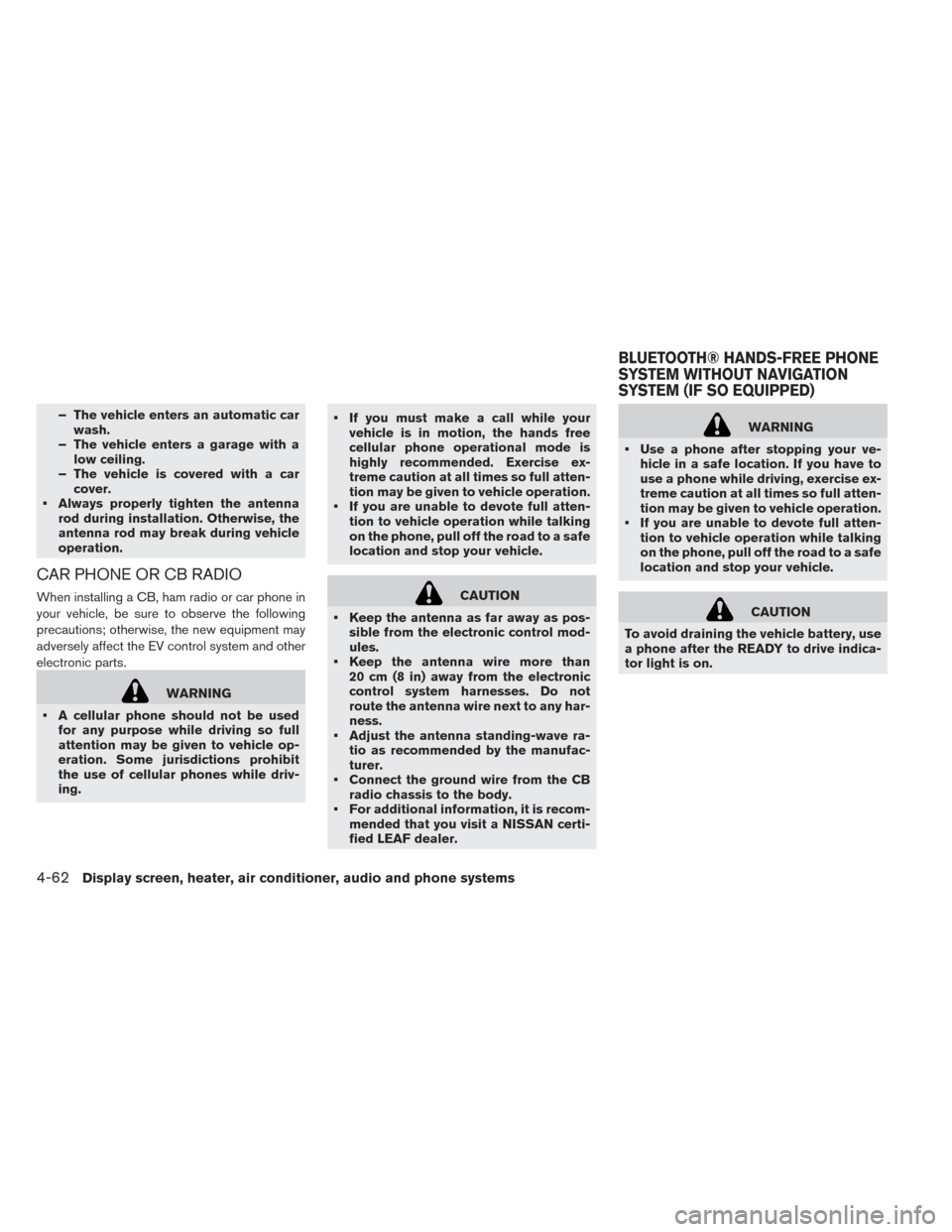
– The vehicle enters an automatic carwash.
– The vehicle enters a garage with a low ceiling.
– The vehicle is covered with a car cover.
• Always properly tighten the antenna rod during installation. Otherwise, the
antenna rod may break during vehicle
operation.
CAR PHONE OR CB RADIO
When installing a CB, ham radio or car phone in
your vehicle, be sure to observe the following
precautions; otherwise, the new equipment may
adversely affect the EV control system and other
electronic parts.
WARNING
• A cellular phone should not be used for any purpose while driving so full
attention may be given to vehicle op-
eration. Some jurisdictions prohibit
the use of cellular phones while driv-
ing. • If you must make a call while your
vehicle is in motion, the hands free
cellular phone operational mode is
highly recommended. Exercise ex-
treme caution at all times so full atten-
tion may be given to vehicle operation.
• If you are unable to devote full atten- tion to vehicle operation while talking
on the phone, pull off the road to a safe
location and stop your vehicle.
CAUTION
• Keep the antenna as far away as pos- sible from the electronic control mod-
ules.
• Keep the antenna wire more than 20 cm (8 in) away from the electronic
control system harnesses. Do not
route the antenna wire next to any har-
ness.
• Adjust the antenna standing-wave ra- tio as recommended by the manufac-
turer.
• Connect the ground wire from the CB radio chassis to the body.
• For additional information, it is recom- mended that you visit a NISSAN certi-
fied LEAF dealer.
WARNING
• Use a phone after stopping your ve- hicle in a safe location. If you have to
use a phone while driving, exercise ex-
treme caution at all times so full atten-
tion may be given to vehicle operation.
• If you are unable to devote full atten- tion to vehicle operation while talking
on the phone, pull off the road to a safe
location and stop your vehicle.
CAUTION
To avoid draining the vehicle battery, use
a phone after the READY to drive indica-
tor light is on.
BLUETOOTH® HANDS-FREE PHONE
SYSTEM WITHOUT NAVIGATION
SYSTEM (IF SO EQUIPPED)
4-62Display screen, heater, air conditioner, audio and phone systems
Page 293 of 424
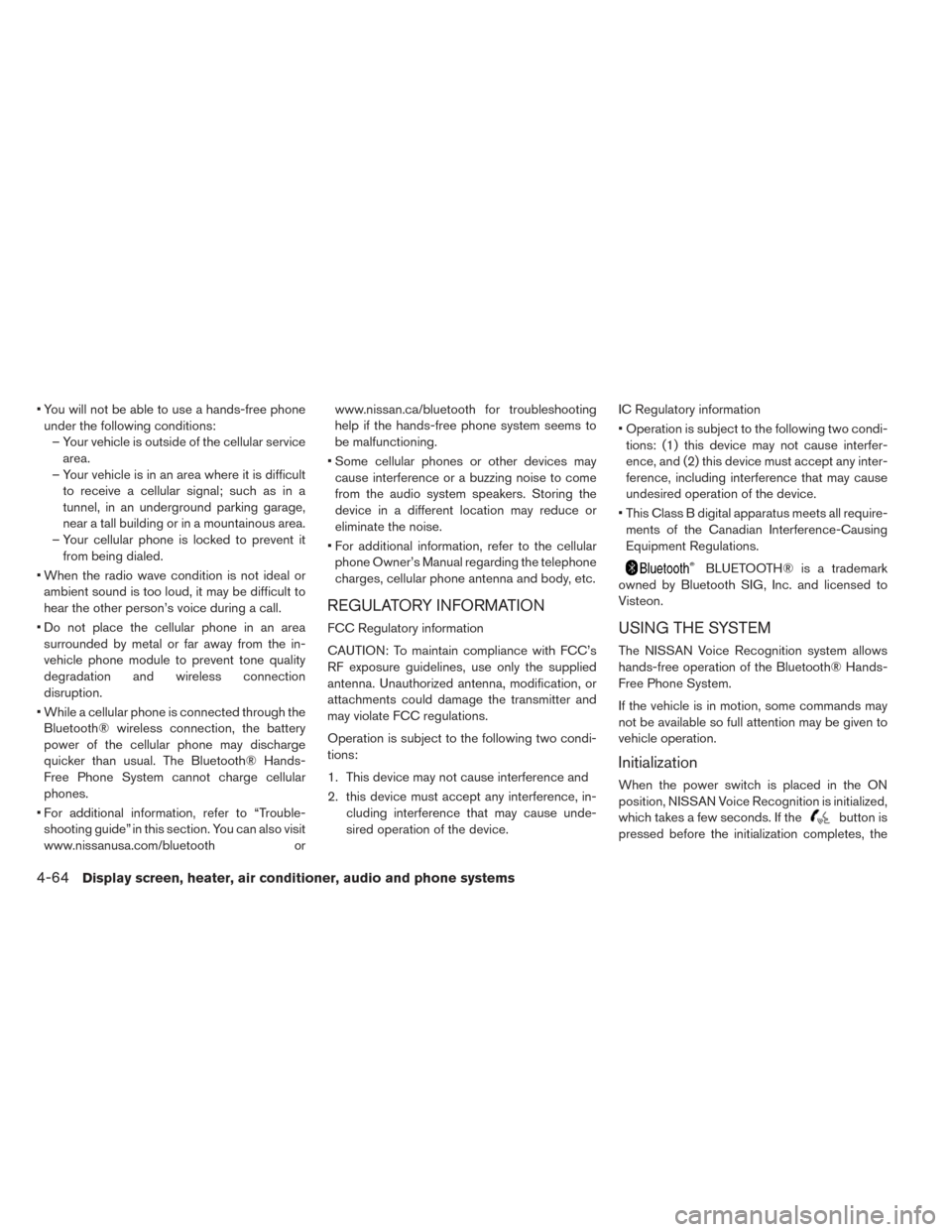
• You will not be able to use a hands-free phoneunder the following conditions: – Your vehicle is outside of the cellular service area.
– Your vehicle is in an area where it is difficult to receive a cellular signal; such as in a
tunnel, in an underground parking garage,
near a tall building or in a mountainous area.
– Your cellular phone is locked to prevent it from being dialed.
• When the radio wave condition is not ideal or ambient sound is too loud, it may be difficult to
hear the other person’s voice during a call.
• Do not place the cellular phone in an area surrounded by metal or far away from the in-
vehicle phone module to prevent tone quality
degradation and wireless connection
disruption.
• While a cellular phone is connected through the Bluetooth® wireless connection, the battery
power of the cellular phone may discharge
quicker than usual. The Bluetooth® Hands-
Free Phone System cannot charge cellular
phones.
• For additional information, refer to “Trouble- shooting guide” in this section. You can also visit
www.nissanusa.com/bluetooth orwww.nissan.ca/bluetooth for troubleshooting
help if the hands-free phone system seems to
be malfunctioning.
• Some cellular phones or other devices may cause interference or a buzzing noise to come
from the audio system speakers. Storing the
device in a different location may reduce or
eliminate the noise.
• For additional information, refer to the cellular phone Owner’s Manual regarding the telephone
charges, cellular phone antenna and body, etc.
REGULATORY INFORMATION
FCC Regulatory information
CAUTION: To maintain compliance with FCC’s
RF exposure guidelines, use only the supplied
antenna. Unauthorized antenna, modification, or
attachments could damage the transmitter and
may violate FCC regulations.
Operation is subject to the following two condi-
tions:
1. This device may not cause interference and
2. this device must accept any interference, in- cluding interference that may cause unde-
sired operation of the device. IC Regulatory information
• Operation is subject to the following two condi-
tions: (1) this device may not cause interfer-
ence, and (2) this device must accept any inter-
ference, including interference that may cause
undesired operation of the device.
• This Class B digital apparatus meets all require- ments of the Canadian Interference-Causing
Equipment Regulations.
BLUETOOTH® is a trademark
owned by Bluetooth SIG, Inc. and licensed to
Visteon.
USING THE SYSTEM
The NISSAN Voice Recognition system allows
hands-free operation of the Bluetooth® Hands-
Free Phone System.
If the vehicle is in motion, some commands may
not be available so full attention may be given to
vehicle operation.
Initialization
When the power switch is placed in the ON
position, NISSAN Voice Recognition is initialized,
which takes a few seconds. If the
button is
pressed before the initialization completes, the
4-64Display screen, heater, air conditioner, audio and phone systems
Page 309 of 424
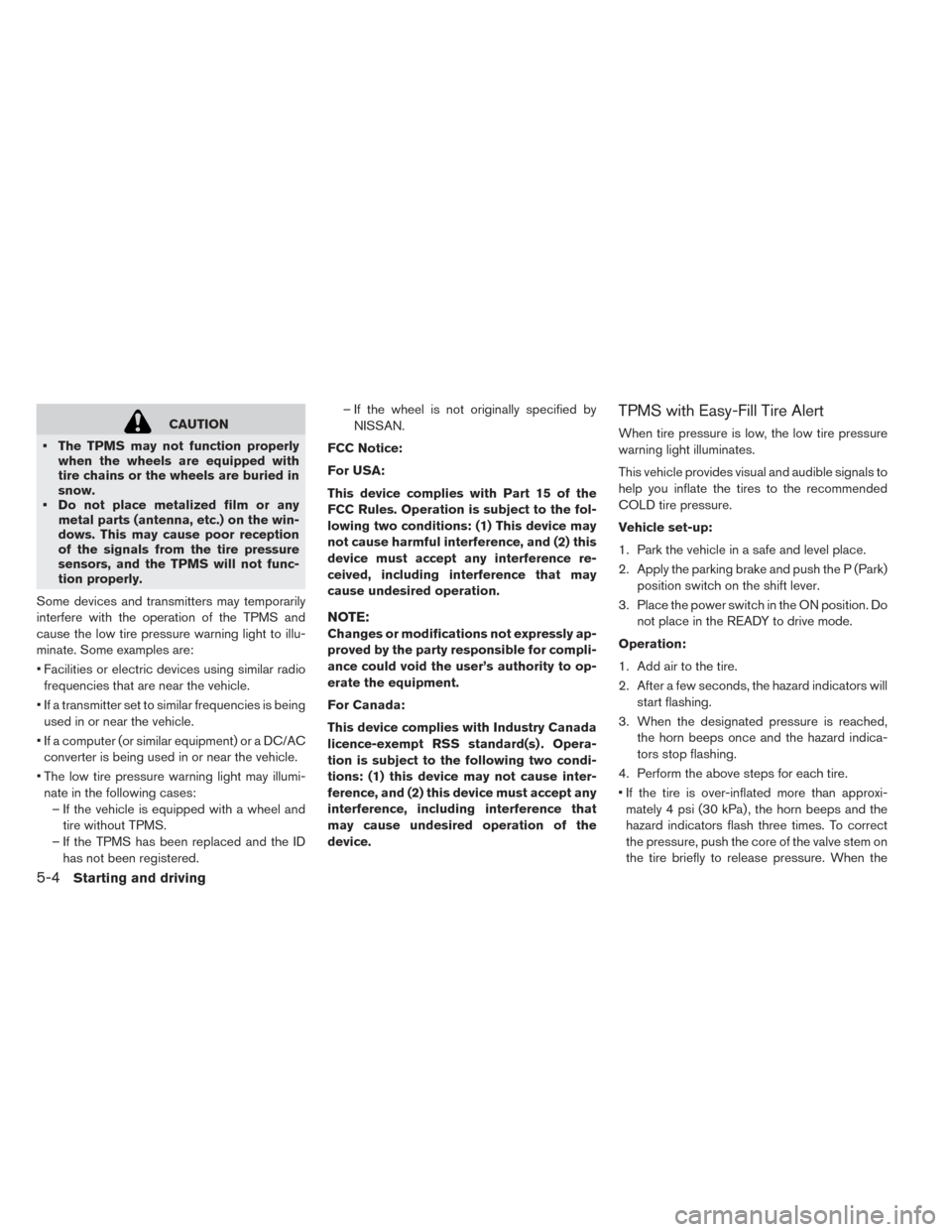
CAUTION
• The TPMS may not function properly when the wheels are equipped with
tire chains or the wheels are buried in
snow.
• Do not place metalized film or any metal parts (antenna, etc.) on the win-
dows. This may cause poor reception
of the signals from the tire pressure
sensors, and the TPMS will not func-
tion properly.
Some devices and transmitters may temporarily
interfere with the operation of the TPMS and
cause the low tire pressure warning light to illu-
minate. Some examples are:
• Facilities or electric devices using similar radio frequencies that are near the vehicle.
• If a transmitter set to similar frequencies is being used in or near the vehicle.
• If a computer (or similar equipment) or a DC/AC converter is being used in or near the vehicle.
• The low tire pressure warning light may illumi- nate in the following cases: – If the vehicle is equipped with a wheel and tire without TPMS.
– If the TPMS has been replaced and the ID has not been registered. – If the wheel is not originally specified by
NISSAN.
FCC Notice:
For USA:
This device complies with Part 15 of the
FCC Rules. Operation is subject to the fol-
lowing two conditions: (1) This device may
not cause harmful interference, and (2) this
device must accept any interference re-
ceived, including interference that may
cause undesired operation.
NOTE:
Changes or modifications not expressly ap-
proved by the party responsible for compli-
ance could void the user’s authority to op-
erate the equipment.
For Canada:
This device complies with Industry Canada
licence-exempt RSS standard(s) . Opera-
tion is subject to the following two condi-
tions: (1) this device may not cause inter-
ference, and (2) this device must accept any
interference, including interference that
may cause undesired operation of the
device.
TPMS with Easy-Fill Tire Alert
When tire pressure is low, the low tire pressure
warning light illuminates.
This vehicle provides visual and audible signals to
help you inflate the tires to the recommended
COLD tire pressure.
Vehicle set-up:
1. Park the vehicle in a safe and level place.
2. Apply the parking brake and push the P (Park) position switch on the shift lever.
3. Place the power switch in the ON position. Do not place in the READY to drive mode.
Operation:
1. Add air to the tire.
2. After a few seconds, the hazard indicators will start flashing.
3. When the designated pressure is reached, the horn beeps once and the hazard indica-
tors stop flashing.
4. Perform the above steps for each tire.
• If the tire is over-inflated more than approxi- mately 4 psi (30 kPa) , the horn beeps and the
hazard indicators flash three times. To correct
the pressure, push the core of the valve stem on
the tire briefly to release pressure. When the
5-4Starting and driving
Page 352 of 424
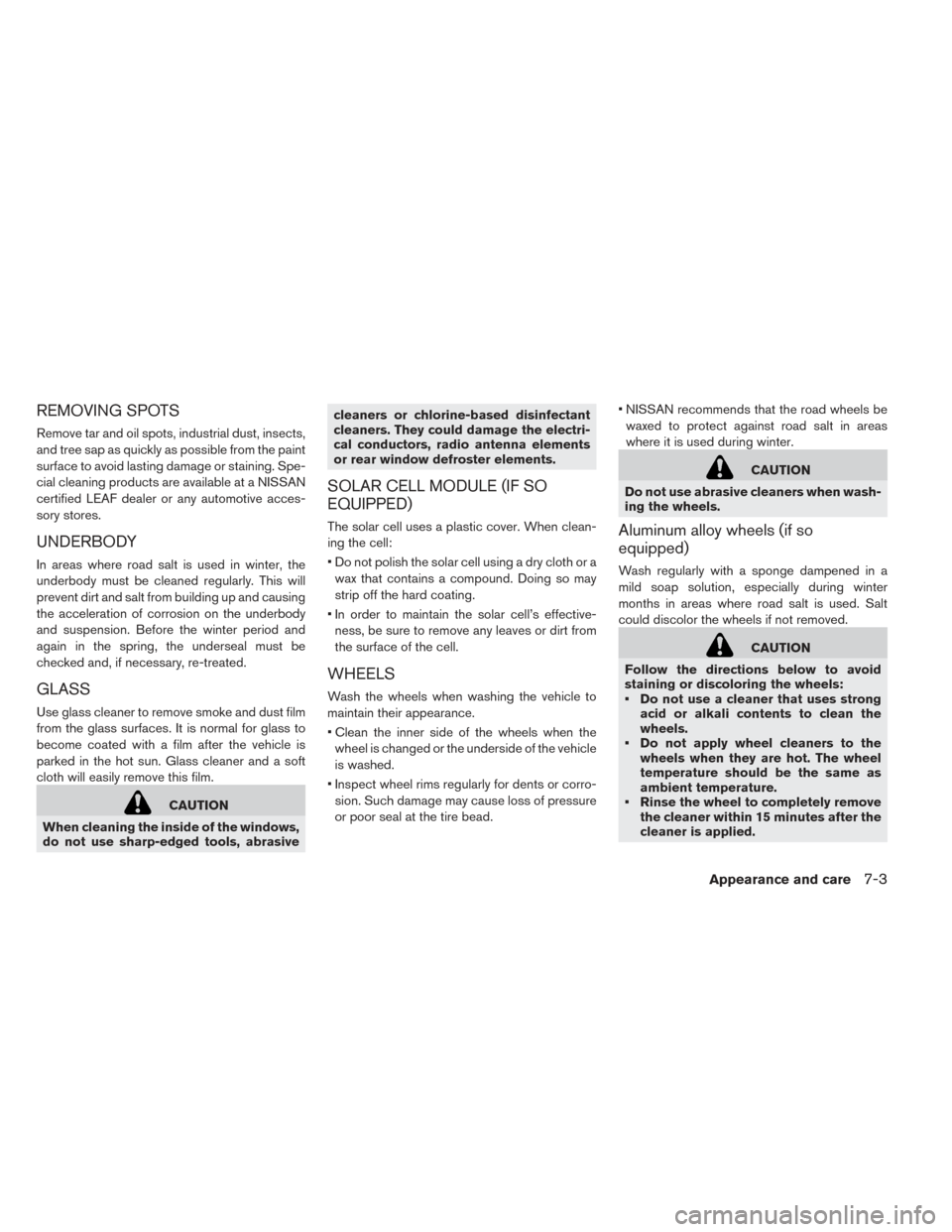
REMOVING SPOTS
Remove tar and oil spots, industrial dust, insects,
and tree sap as quickly as possible from the paint
surface to avoid lasting damage or staining. Spe-
cial cleaning products are available at a NISSAN
certified LEAF dealer or any automotive acces-
sory stores.
UNDERBODY
In areas where road salt is used in winter, the
underbody must be cleaned regularly. This will
prevent dirt and salt from building up and causing
the acceleration of corrosion on the underbody
and suspension. Before the winter period and
again in the spring, the underseal must be
checked and, if necessary, re-treated.
GLASS
Use glass cleaner to remove smoke and dust film
from the glass surfaces. It is normal for glass to
become coated with a film after the vehicle is
parked in the hot sun. Glass cleaner and a soft
cloth will easily remove this film.
CAUTION
When cleaning the inside of the windows,
do not use sharp-edged tools, abrasive cleaners or chlorine-based disinfectant
cleaners. They could damage the electri-
cal conductors, radio antenna elements
or rear window defroster elements.
SOLAR CELL MODULE (IF SO
EQUIPPED)
The solar cell uses a plastic cover. When clean-
ing the cell:
• Do not polish the solar cell using a dry cloth or a
wax that contains a compound. Doing so may
strip off the hard coating.
• In order to maintain the solar cell’s effective- ness, be sure to remove any leaves or dirt from
the surface of the cell.
WHEELS
Wash the wheels when washing the vehicle to
maintain their appearance.
• Clean the inner side of the wheels when thewheel is changed or the underside of the vehicle
is washed.
• Inspect wheel rims regularly for dents or corro- sion. Such damage may cause loss of pressure
or poor seal at the tire bead. • NISSAN recommends that the road wheels be
waxed to protect against road salt in areas
where it is used during winter.
CAUTION
Do not use abrasive cleaners when wash-
ing the wheels.
Aluminum alloy wheels (if so
equipped)
Wash regularly with a sponge dampened in a
mild soap solution, especially during winter
months in areas where road salt is used. Salt
could discolor the wheels if not removed.
CAUTION
Follow the directions below to avoid
staining or discoloring the wheels:
• Do not use a cleaner that uses strong acid or alkali contents to clean the
wheels.
• Do not apply wheel cleaners to the wheels when they are hot. The wheel
temperature should be the same as
ambient temperature.
• Rinse the wheel to completely remove the cleaner within 15 minutes after the
cleaner is applied.
Appearance and care7-3